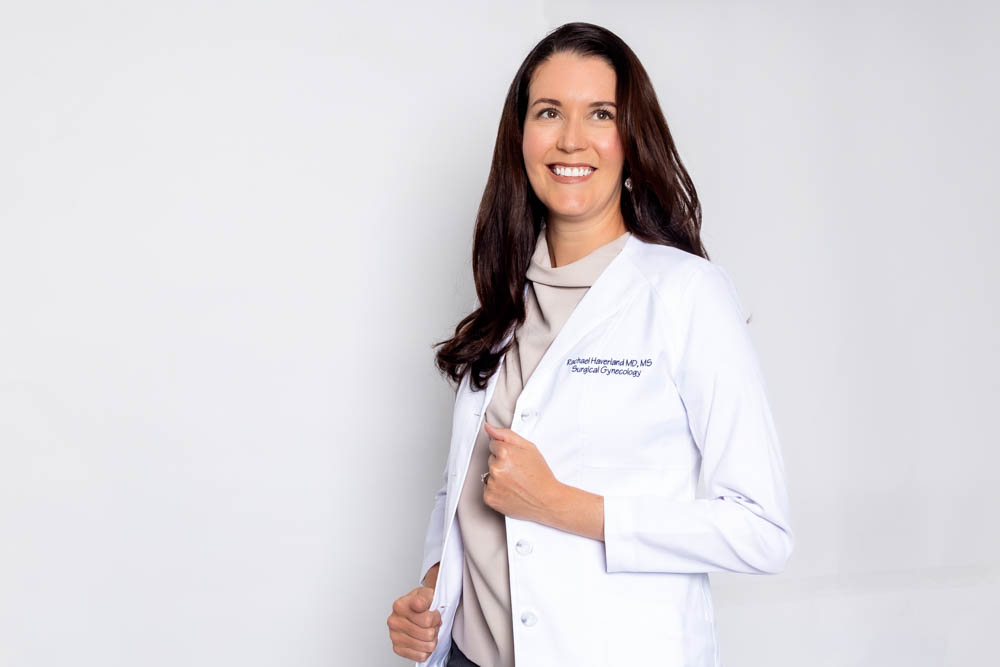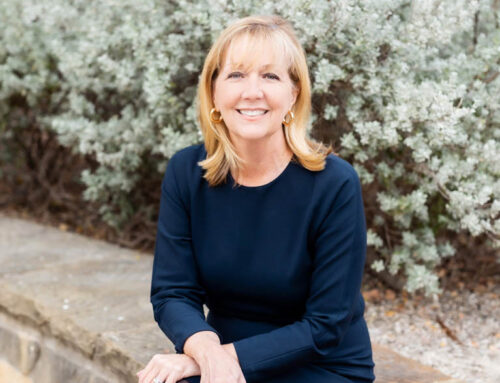
Photography by Amani Sodiq
It’s one of the most painful chronic illnesses in the world, sneakily causing debilitating pain for millions of women. You can almost never see it on an ultrasound or other scans. It often takes 10 years for a woman to get diagnosed with it, and even longer, if ever, to receive treatment. And even though it’s estimated that one in eight women will be diagnosed with the condition, few doctors know how to diagnose it. Even fewer can effectively treat it. Though not considered a fatal condition, the pain felt from endometriosis is known to greatly impact quality of life, and often leads to mental health struggles when left untreated.
One of these rare doctors is Rachael Haverland, a pelvic surgeon and endometriosis specialist at Pelvic Rehabilitation Medicine in the Preston Hollow area.
“I always knew I wanted to be involved in women’s health. From the very beginning, when I went to med school, I just knew that was my calling,” Haverland says. “I felt very comfortable in the space.”
While in her obstetrics and gynecology residency, Haverland learned a lot about obstetrics — the field of study concerning pregnancy, childbirth and postpartum care — but found that other women’s health issues were not focused upon as much.
“I felt like it was a space that was very underserved and I felt like I could treat people surgically and through other modalities rather than just focusing on pregnancy,” she says.
Haverland then did a fellowship at the Mayo Clinic under Javier Magrina, a former oncologist who is known as a pioneer for endometriosis surgery, demonstrating that removing the disease rather than burning it delivered better outcomes.
“It was so rewarding as I got into it,” Haverland says. “I realized that my job was actually very easy. I just listen and believe women and believe their symptoms and then we come up with a treatment plan together.”
Haverland met her now-husband in medical school, got married one week after graduating and the pair moved to Phoenix together for their respective residencies — Rachael’s in obstetrics and gynecology and Joshua’s in pediatrics.
The Haverlands live in the White Rock Valley with their three sons, aged 6, 3 and 1½, where they spend their weekends playing soccer and enjoying the outdoor amenities that the area has to offer.
“I always dreamed of having this strong daughter that I could raise to be independent,” Haverland says. “Now, I just do that through my work and I’m going to teach my boys how to treat women with respect … When everybody is advocating for the same purpose and the same cause, whether men or women, you get better outcomes when everybody helps.”
Endometriosis
Endometriosis is a disease in (mostly) women where cells similar to those growing inside the lining of the uterus (endometrium) grow outside of the uterus on other organs.
Usually, these cells will grow on pelvic organs such as the bladder, outside of the uterus or the colon, but endometriosis has been found on nearly every organ in the body. These cells cause chronic inflammation, which causes pain, and the longer the cells are there, the more that they grow and the more permanent damage is caused to the surrounding nerves and muscles.
“A lot of endometriosis can be genetic,” she says. “There’s a strong propensity with first degree relatives or second-degree relatives to have endometriosis and usually women that have a genetic predisposition are diagnosed with more aggressive disease and more advanced disease because it’s more aggressive.”
While research on fertility with endometriosis has been more extensively studied, endometriosis can reduce the likelihood of becoming pregnant by up to 50%, according to Massachusetts General Hospital.
“One of my goals in my career is to try to advocate for women and endometriosis and pelvic pain and hopefully decrease that time where you can come up with symptoms and get a diagnosis and ultimately treatment,” Haverland says. “The younger we can treat endometriosis, the better your outcomes are.”

Paths to diagnosis
Endometriosis is “vastly underdiagnosed,” and about one in eight women are diagnosed in their lifetime.
According to Haverland, there are many factors contributing to underdiagnosis, like a lack of knowledgeable doctors, stigma surrounding discussing periods and women’s health and absence of research on the disease in general.
“Knowledge is power,” Haverland says. “We can bring this issue to the forefront and let people know that their symptoms are not normal … and when people talk about it, it’s OK to give them support and validate their symptoms. The more that we do that, the more women understand what’s normal and what’s not normal and the quicker that we’re going to be able to get to the point where more people have access and more people have quality care for endometriosis and treatment.”
In a 2023 qualitative review of doctors and patients’ knowledge of endometriosis, many doctors reported that they hadn’t learned about the disease at all or that it was only briefly mentioned in medical school. Others said that women’s health wasn’t a required curriculum when they were training.
Awareness of the disease has increased vastly in the last five years, according to a recent UCLA Health article, in part by growing discussions among those diagnosed in online communities.
Many in the online community have focused on spreading the mantra, “periods are not supposed to be painful,” as painful menstruation, or dysmenorrhea, is a key symptom to endometriosis.
“Most doctors tell patients that painful periods are normal, that painful periods are something that all women deal with and that some people just have a lower pain tolerance,” TikTok creator @endometriosisem said in a post earlier this year. “You know your body best, don’t let anybody convince you otherwise.”
“There’s a little bit of patriarchy hidden in medicine,” Haverland says. “[There is a belief that] women are more likely to be histrionic and have anxiety. There is an emotional component associated with endometriosis, but it’s more related to when you’re in chronic pain, how could it not affect you emotionally? … If you just treat anxiety or depression and you don’t treat the underlying etiology, you’re not going to get any better.”
Pelvic Rehabilitation Medicine
Haverland joined the Pelvic Rehabilitation Medicine (PRM) team in 2022. PRM has 14 locations across nine states, with Texas offices in Dallas and Houston.
“It’s a specialty that is niche in this space where I get to do what I love and take care of a population where I feel really rewarded,” Haverland says. “It’s a very cool job and I love coming to work every day … I feel humbled and very honored.”
The clinics specialize in office-based pelvic pain treatment through direct treatment of inflamed pelvic nerves and spastic pelvic muscles to reduce symptoms in conditions in men and women, including endometriosis, pelvic inflammatory diseases, erectile dysfunction and hernias.
“They have a different way that they address and evaluate pelvic pain, so they use nonnarcotic options for pain relief,” Haverland says. “[We are] downregulating what we call the central sensitization of pain. When your nerves have been in pain for years and years, all they know is to send pain signals to your brain, so we’re trying to reset that and let the nerves heal.”
Haverland is joined by pelvic pain specialists Rucha Kapadia and Myesha Banks and integrative nutritional health coach Monique Bogni at PRM’s Dallas location, aiming to provide comprehensive care in reducing and eliminating pelvic pain.
Haverland’s mark
Even with places like Pelvic Rehabilitation Medicine cropping up all over the country, the Endometriosis Foundation of America finds that out of over 40,000 OB/GYNs in the United States, there are only about 100 endometriosis specialists skilled in the most up-to-date treatment options.
One hundred specialists. And more than six million women with the condition.
“It’s really unfortunate, but with fellowships becoming more prevalent, hopefully we’ll get more people that really dive into the endometriosis space, because it is so needed,” Haverland says. “If it’s one in eight women, it’s very common and more people need help.”
To guide those who suspect that they have the condition, resources like Nancy’s Nook, an online learning library centered around the latest endometriosis research, are growing in members. Nancy’s Nook’s Facebook group itself has over 200,000 members worldwide.
Here, many women share their experience with Haverland and other Nook-verified experts and note the difference in their quality of life after getting diagnosed and having surgery to remove the endometriosis itself. Haverland often shares research and images from surgery with the group.
Aside from patient care, Haverland has participated in research that has helped define standards of care in the field with several published works in the Journal of Minimally Invasive Gynecology on pelvic reconstruction, deep infiltrating endometriosis, longitudinal vaginal septum and practices to mitigate the opioid epidemic, among articles in other journals.
On top of educating and researching standards of practice for other doctors, Haverland attends forums and conferences like The Endometriosis Summit and works with nonprofits like The Endo Forward Foundation.
She also frequently posts to online forums regarding various topics related to the disease, including YouTube videos on Pelvic Rehabilitation’s YouTube channel answering frequently asked questions to educate the public.
“There’s a lot of boundaries to care right now for women, but hopefully, as we talk more about endometriosis, advocate for more treatment options and for more affordable options, more people will be able to get treatment easier.”





